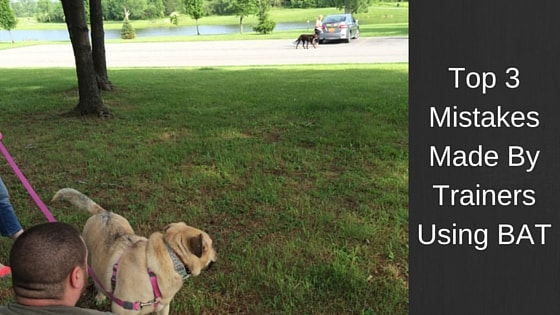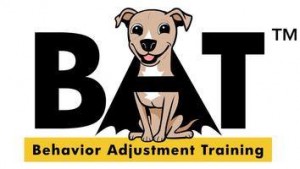
This is part 3 of a 3-part series on Behavior Adjustment Training (BAT), created by Grisha Stewart. In the first posting you learned about the basics of BAT and how a “perfect” session should look. In part 2, you learned why it is so effective for reactive/aggressive dogs. This final installment is to discuss the three most common mistakes made by trainers utilizing BAT. Though the technique is simple in theory, perfecting it takes time.
1. Leading The Dog
 Letting the dog pick his own direction and speed of movement is probably the hardest thing for trainers and clients to do. BAT is very calm, and it is easy to slip into the mindset of, “he’s doing really well, so let’s encourage him to go a little closer to his trigger!” BAT is about empowering the dog and allowing him to make his own correct choices.
Letting the dog pick his own direction and speed of movement is probably the hardest thing for trainers and clients to do. BAT is very calm, and it is easy to slip into the mindset of, “he’s doing really well, so let’s encourage him to go a little closer to his trigger!” BAT is about empowering the dog and allowing him to make his own correct choices.
When doing BAT, you want the dog to investigate his surroundings and sniff his way around. Even though it may seem like he is ignoring the trigger/decoy, he knows it is there and is gathering information in his own manner. As a trainer, you want to encourage your client to stand back and follow the dog’s lead. Even subtle body shifts on the behalf of the handler can encourage the dog to move faster than he is comfortable doing, so make sure you encourage your clients to remain entirely neutral regarding movement.
2. Letting The Dog Go Over Threshold
Remember in part one where the lifeguard analogy was used? It is your job as a trainer to help the client keep the dog from “drowning,” or getting too close to his trigger. You want the dog close enough that he is aware of the trigger and is gathering information in a very relaxed manner. If you see him start to tense up, or stare a little longer, or start moving faster, you need to help his owner guide him a little further back up the beach into safe territory.
As stated above, it is too easy to think that the dog is unaware of the trigger. This is where your expertise in body language becomes critical. You need to help your clients learn to see that minute changes in the dog’s body that indicate he is starting to get a little over aroused, and then ensure they have the leash skills necessary to gently guide him away.
3. Guiding The Dog Into “Training Mode”
Since most, if not all, of your BAT clients will be proponents of force free training, their dogs are probably very familiar with what treats mean: TRAINING. And they love training, because training = TREATS! Obviously this is not a bad thing by any means. However, when doing BAT, you want to try to keep the dog out of training mode. By training mode, I mean that lovely “what do you want me to do next for you, huh huh huh???” attention that the dogs often go into due to their eagerness to work with their owners. Training mode is a lovely thing to see. Just not during BAT!
Dogs in training mode often are very good at tuning out many lesser distractions. This means they may not notice their trigger until they’ve worked their way too close, at which point they rapidly go over threshold. You want the dog to stay in relaxed leisure mode. This is why it’s so important that if you are going to “seed” the ground with some treats to encourage sniffing and exploring, that you do so when the dog is not watching you.
Want To Learn More?
BAT is very complex and one little series of blogs does not do it the justice it deserves. To learn more, you can watch a lovely free BAT Overview video that Grisha offers.
You can also watch a full 2 hour BAT Intro Webinar that Grisha put out. It is $29 but well worth the money if BAT is something you’d like in your toolbox.
Finally, to get the full immersion and become more proficient and comfortable in its use, you can take an online course called BAT 101.
Get Dog Training Business Tips!
Receive valuable dog training business tips and resources every week! Subscribe to The Modern Dog Trainer now by submitting your name and email below.
[mc4wp_form]



